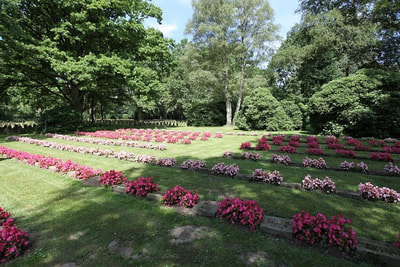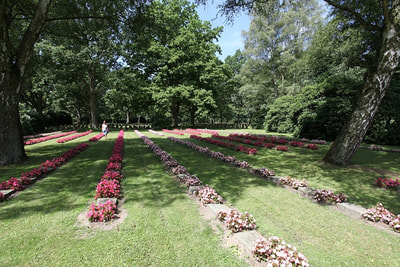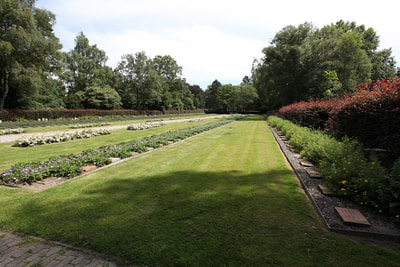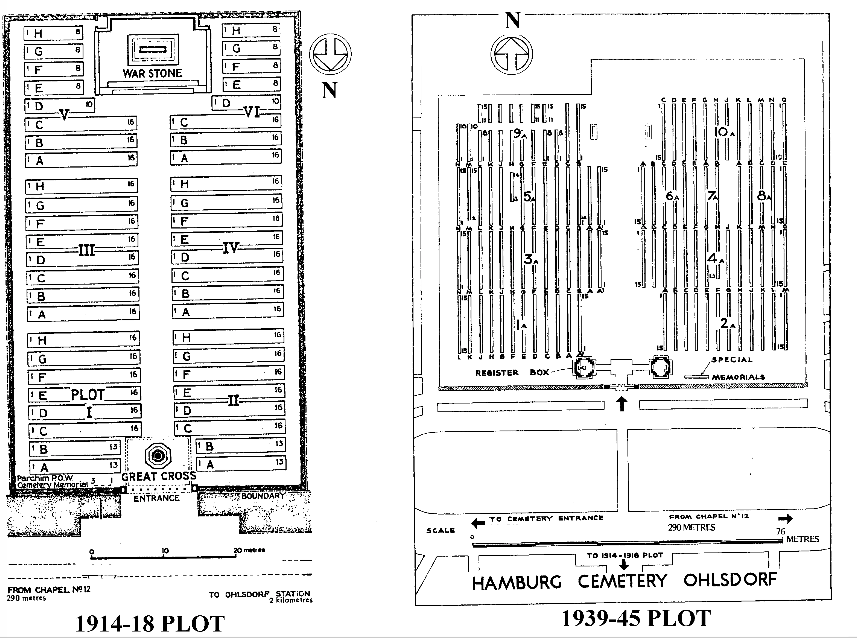HAMBURG CEMETERY
Hamburg Metropolitan Region
Germany
Location Information
Hamburg is a large city in the north of Germany, approx 150kms to the north of Hannover. Hamburg Ohlsdorf Cemetery (Friedhof Ohlsdorf) is the biggest non-military cemetery in the world. There are 3 Commonwealth War Graves plots located within Hamburg Ohlsdorf Cemetery:- Hamburg Cemetery Ohlsdorf 1914-1918 / Hamburg Cemetery Ohlsdorf 1939-1945 / Hamburg Cemetery Ohlsdorf Post War.
From the A7 Hannover to Hamburg motorway take exit 23 (Ausfahrt 23) B432 NORDERSTEDT / HAMBURG AIRPORT / LANGENHORN.
Follow the signs for B432 HAMBURG AIRPORT / LANGENHORN along the OLDESLOERSTRASSE. After approx 1.5kms keep right onto the B433 SWEBENWEG and continue to follow the signs for HAMBURG AIRPORT / LANGENHORN.
Continue for approx 1.5kms and keep left onto the KROHNSTEIG for approx 2.5kms until the junction with LAGENHORNER CHAUSEE.
Turn right onto the LAGENHORNER CHAUSEE and continue for approx 2kms.
Turn left onto ERDKAMPSEWEG direction BARMBEK and continue for approx 2kms, during which the road name changes to RATSMUHLENDAMM and then FUHLBUTTLERSTRASSE.
Immediately before the railway bridge turn right (signposted FRIEDHOF OHLSDORF) onto IM GRUNEN GRUNDE and continue for approx 500m. Turn left onto ALSTERDORFER STRASSE, go under the railway bridge and continue for 200m to the junction with FUHLBUTTLERSTRASSE.
The main entrance to Hamburg Ohlsdorf Cemetery (Friedhof Ohlsdorf) is directly in front of you.
The 3 Commonwealth War Graves plots are located approx 3kms from the main entrance and are clearly signposted.
Follow direction for KAPELLE 12 for approx 2.5kms along the CORDESALLEE / SUDALLEE / MITTELALLEE, turn right and continue past KAPELLE 12, turn right onto LARCHENALLEE and after approx 300m the cemeteries can be found on the left and right.
Visitors are advised that there is a strictly controlled 30km/hour speed limit within the boundaries of Hamburg Ohlsdorf Cemetery (Friedhof Ohlsdorf).
Please note also that it is illegal to turn left from FUHLBUTTLERSTRASSE into the Hamburg Ohlsdorf Cemetery (Friedhof Ohlsdorf)
The cemetery address is:-
Friedhof Ohlsdorf
Fuhlsbuttlerstrasse 756
22337 Hamburg
Germany
GPS Location is:- N 53 37 20 E 10 04 01
Visiting Information
Cemetery Opening Hours:
Summer (April to Oct): 09.00 to 21.00 (7 days a week)
Winter (November to March): 09.00 to 18.00 (7 days a week)
The Commission plot is signposted in the Cemetery and is located 300 metres from the Chapel.
Wheelchair access possible via main entrance.
Historical Information
During the First World War, Hamburg Cemetery was used for the burial of over 300 Allied servicemen who died as prisoners of war. In 1923, it was decided that the graves of Commonwealth servicemen who had died all over Germany should be brought together into four permanent cemeteries. Hamburg was one of those chosen, and burials were brought into the cemetery from 120 burial grounds* in Schleswig-Holstein, Mecklenburg, Oldenburg, Hanover, Saxony, Brunswick and Westphalia. The majority died as prisoners, but a few were sailors whose bodies were washed ashore on the Frisian Islands.
There are now 708 First World War servicemen buried or commemorated in the Commonwealth plot at Hamburg. This total includes special memorials to three casualties buried in Parchim Prisoners of War Cemetery whose graves could not be found, and 25 unidentified sailors whose remains were recovered from HM Submarine E24, which was sunk by a mine off Heligoland in March 1916, when the vessel was raised in July 1974.
The Commonwealth section of the cemetery also contains 1,466 Second World War burials, mostly of servicemen who died with the occupying forces, or airmen lost in bombing raids over Germany. There are also 378 post Second World War graves and 14 war graves of other nationalities.
* The following cemeteries are among those from which graves were brought to Hamburg:
GUSTROW PRISONERS OF WAR CEMETERY, Mecklenburg-Schwerin. 59 burials of 1914-1918. Gustrow was one of the main camps in which prisoners in Germany were registered.
HANNOVER (LIMMER) MILITARY CEMETERY, Hannover. 31 burials of 1914-1918.
HELIGOLAND CHURCHYARD, Helgoland. one burial of 1916.
MINDERHEIDE PRISONERS OF WAR CEMETERY, Westphalia. 55 burials of 1916-1918.
MUNSTER CAMP PRISONERS OF WAR CEMETERY, Hannover. 130 burials of 1917-1919.
PARCHIM PRISONERS OF WAR CEMETERY, Mecklenburg Schwerin. 83 burials of 1917-1919.
SOLTAU PRISONERS OF WAR CEMETERY, Hannover. 25 burials of 1916-1918.
VERDEN GARRISON CEMETERY, Hannover. 29 burials of 1916-1918.
Pictures in gallery below © Åge Jakobsen
Hamburg is a large city in the north of Germany, approx 150kms to the north of Hannover. Hamburg Ohlsdorf Cemetery (Friedhof Ohlsdorf) is the biggest non-military cemetery in the world. There are 3 Commonwealth War Graves plots located within Hamburg Ohlsdorf Cemetery:- Hamburg Cemetery Ohlsdorf 1914-1918 / Hamburg Cemetery Ohlsdorf 1939-1945 / Hamburg Cemetery Ohlsdorf Post War.
From the A7 Hannover to Hamburg motorway take exit 23 (Ausfahrt 23) B432 NORDERSTEDT / HAMBURG AIRPORT / LANGENHORN.
Follow the signs for B432 HAMBURG AIRPORT / LANGENHORN along the OLDESLOERSTRASSE. After approx 1.5kms keep right onto the B433 SWEBENWEG and continue to follow the signs for HAMBURG AIRPORT / LANGENHORN.
Continue for approx 1.5kms and keep left onto the KROHNSTEIG for approx 2.5kms until the junction with LAGENHORNER CHAUSEE.
Turn right onto the LAGENHORNER CHAUSEE and continue for approx 2kms.
Turn left onto ERDKAMPSEWEG direction BARMBEK and continue for approx 2kms, during which the road name changes to RATSMUHLENDAMM and then FUHLBUTTLERSTRASSE.
Immediately before the railway bridge turn right (signposted FRIEDHOF OHLSDORF) onto IM GRUNEN GRUNDE and continue for approx 500m. Turn left onto ALSTERDORFER STRASSE, go under the railway bridge and continue for 200m to the junction with FUHLBUTTLERSTRASSE.
The main entrance to Hamburg Ohlsdorf Cemetery (Friedhof Ohlsdorf) is directly in front of you.
The 3 Commonwealth War Graves plots are located approx 3kms from the main entrance and are clearly signposted.
Follow direction for KAPELLE 12 for approx 2.5kms along the CORDESALLEE / SUDALLEE / MITTELALLEE, turn right and continue past KAPELLE 12, turn right onto LARCHENALLEE and after approx 300m the cemeteries can be found on the left and right.
Visitors are advised that there is a strictly controlled 30km/hour speed limit within the boundaries of Hamburg Ohlsdorf Cemetery (Friedhof Ohlsdorf).
Please note also that it is illegal to turn left from FUHLBUTTLERSTRASSE into the Hamburg Ohlsdorf Cemetery (Friedhof Ohlsdorf)
The cemetery address is:-
Friedhof Ohlsdorf
Fuhlsbuttlerstrasse 756
22337 Hamburg
Germany
GPS Location is:- N 53 37 20 E 10 04 01
Visiting Information
Cemetery Opening Hours:
Summer (April to Oct): 09.00 to 21.00 (7 days a week)
Winter (November to March): 09.00 to 18.00 (7 days a week)
The Commission plot is signposted in the Cemetery and is located 300 metres from the Chapel.
Wheelchair access possible via main entrance.
Historical Information
During the First World War, Hamburg Cemetery was used for the burial of over 300 Allied servicemen who died as prisoners of war. In 1923, it was decided that the graves of Commonwealth servicemen who had died all over Germany should be brought together into four permanent cemeteries. Hamburg was one of those chosen, and burials were brought into the cemetery from 120 burial grounds* in Schleswig-Holstein, Mecklenburg, Oldenburg, Hanover, Saxony, Brunswick and Westphalia. The majority died as prisoners, but a few were sailors whose bodies were washed ashore on the Frisian Islands.
There are now 708 First World War servicemen buried or commemorated in the Commonwealth plot at Hamburg. This total includes special memorials to three casualties buried in Parchim Prisoners of War Cemetery whose graves could not be found, and 25 unidentified sailors whose remains were recovered from HM Submarine E24, which was sunk by a mine off Heligoland in March 1916, when the vessel was raised in July 1974.
The Commonwealth section of the cemetery also contains 1,466 Second World War burials, mostly of servicemen who died with the occupying forces, or airmen lost in bombing raids over Germany. There are also 378 post Second World War graves and 14 war graves of other nationalities.
* The following cemeteries are among those from which graves were brought to Hamburg:
GUSTROW PRISONERS OF WAR CEMETERY, Mecklenburg-Schwerin. 59 burials of 1914-1918. Gustrow was one of the main camps in which prisoners in Germany were registered.
HANNOVER (LIMMER) MILITARY CEMETERY, Hannover. 31 burials of 1914-1918.
HELIGOLAND CHURCHYARD, Helgoland. one burial of 1916.
MINDERHEIDE PRISONERS OF WAR CEMETERY, Westphalia. 55 burials of 1916-1918.
MUNSTER CAMP PRISONERS OF WAR CEMETERY, Hannover. 130 burials of 1917-1919.
PARCHIM PRISONERS OF WAR CEMETERY, Mecklenburg Schwerin. 83 burials of 1917-1919.
SOLTAU PRISONERS OF WAR CEMETERY, Hannover. 25 burials of 1916-1918.
VERDEN GARRISON CEMETERY, Hannover. 29 burials of 1916-1918.
Pictures in gallery below © Åge Jakobsen
World War One

Lieutenant Colonel Neville Bowes Elliott-Cooper, V. C., D. S. O., M. C.
8th Bn. Royal Fusiliers, died 11th February 1918, aged 29. Plot V. A. 16.
Youngest son of Sir Robert Elliott-Cooper, K.C.B. Born in London. Educated at Eton and Sandhurst.
Citation: An extract from "The London Gazette," dated 12th Feb., 1918, records the following particulars:- "For most conspicuous bravery and devotion to duty. Hearing that the enemy had broken through our outpost line, he rushed out of his dug-out, and on seeing them advancing across the open he mounted the parapet and dashed forward calling upon the Reserve Company and details of the Battalion Headquarters to follow. Absolutely unarmed, he made straight for the advancing enemy, and under his direction our men forced them back 600 yards. While still some forty yards in front he was severely wounded. Realising that his men were greatly outnumbered and suffering heavy casualties, he signalled to them to withdraw, regardless of the fact that he himself must be taken prisoner. By his prompt and gallant leading he gained time for the reserves to move up and occupy the line of defence."
8th Bn. Royal Fusiliers, died 11th February 1918, aged 29. Plot V. A. 16.
Youngest son of Sir Robert Elliott-Cooper, K.C.B. Born in London. Educated at Eton and Sandhurst.
Citation: An extract from "The London Gazette," dated 12th Feb., 1918, records the following particulars:- "For most conspicuous bravery and devotion to duty. Hearing that the enemy had broken through our outpost line, he rushed out of his dug-out, and on seeing them advancing across the open he mounted the parapet and dashed forward calling upon the Reserve Company and details of the Battalion Headquarters to follow. Absolutely unarmed, he made straight for the advancing enemy, and under his direction our men forced them back 600 yards. While still some forty yards in front he was severely wounded. Realising that his men were greatly outnumbered and suffering heavy casualties, he signalled to them to withdraw, regardless of the fact that he himself must be taken prisoner. By his prompt and gallant leading he gained time for the reserves to move up and occupy the line of defence."

26629 Private
Samuel Richardson
4th Bn. Grenadier Guards
Died of Wounds as Prisoner of War, 28th April 1918, aged 32.
Plot IV. C. 14.
Husband of Christiana Richardson, of 27, Ulster St., Burnley, Lancashire.
Samuel Richardson
4th Bn. Grenadier Guards
Died of Wounds as Prisoner of War, 28th April 1918, aged 32.
Plot IV. C. 14.
Husband of Christiana Richardson, of 27, Ulster St., Burnley, Lancashire.

35552 Private
Frank Riley
10th Bn. Royal Warwickshire Regiment
Died of Wounds as a Prisoner of War, 14th June 1918, aged 19.
Plot II. C. 11.
Son of William and Betsy Riley, of 28, Rawson St., Burnley, Lancashire.
Frank Riley
10th Bn. Royal Warwickshire Regiment
Died of Wounds as a Prisoner of War, 14th June 1918, aged 19.
Plot II. C. 11.
Son of William and Betsy Riley, of 28, Rawson St., Burnley, Lancashire.

16590 Private
John William Smith
9th Bn. Cameronian Highlanders (Scottish Rifles)
Died of Wounds as a Prisoner of War, 8th July 1918.
Plot IV. B. 4.
Born Accrington, enlisted Burnley, Lancashire.
John William Smith
9th Bn. Cameronian Highlanders (Scottish Rifles)
Died of Wounds as a Prisoner of War, 8th July 1918.
Plot IV. B. 4.
Born Accrington, enlisted Burnley, Lancashire.

26575 Private
Solomon Sole
13th Bn. East Yorkshire Regiment
5th May 1917.
VI. H. 6.
Remembered by his Great niece Gemma Hewick.
Solomon Sole
13th Bn. East Yorkshire Regiment
5th May 1917.
VI. H. 6.
Remembered by his Great niece Gemma Hewick.
World War Two

401793 Sergeant James Allen Ward, V. C.
75 Squadron, Royal New Zealand Air Force, died 15th September 1941, aged 22. Plot 5A. A1. 9.
Son of Percy Harold Ward and of Ada May Ward (nee Stokes), of Wanganui, Wellington, New Zealand.
Citation: The citation in the London Gazette for 5th August, 1941, gives the following details. On the night of July 7th, 1941, sgt. Ward was second pilot of a Wellington which, while returning from a raid on Munster, was damaged by cannon shell and incendiary bullets from an attacking Messerschmitt 110. Fire broke out near the starboard engine which, fed by petrol from a split pipe, threatened to spread to the entire wing. Strenuous efforts by the crew failed to extinguish the fire, and they were warned to be ready to abandon the aircraft. Sgt. Ward then volunteered to try and smother the fire with an engine cover which chanced to be in use as a cushion. He got through the narrow astro-hatch and, by breaking the fabric to make hand and foot holds, succeeded in climbing on to, and then along, the wing, to a position behind the engine. Lying precariously there he smothered the fire in the wing fabric, and tried to push the engine cover on to the leaking pipe. It was blown back by the terrific wind, and on the second attempt was lost. Nevertheless, the fabric surrounding the pipe was destroyed, so that the fire could not spread and finally burnt itself out. Sgt. Ward, with assistance from the navigator, was able to struggle back into the aircraft, which eventually reached home and landed safely. The flight back was made possible by Sgt. Ward''s most conspicuous bravery in extinguishing the fire at the risk of his life.
75 Squadron, Royal New Zealand Air Force, died 15th September 1941, aged 22. Plot 5A. A1. 9.
Son of Percy Harold Ward and of Ada May Ward (nee Stokes), of Wanganui, Wellington, New Zealand.
Citation: The citation in the London Gazette for 5th August, 1941, gives the following details. On the night of July 7th, 1941, sgt. Ward was second pilot of a Wellington which, while returning from a raid on Munster, was damaged by cannon shell and incendiary bullets from an attacking Messerschmitt 110. Fire broke out near the starboard engine which, fed by petrol from a split pipe, threatened to spread to the entire wing. Strenuous efforts by the crew failed to extinguish the fire, and they were warned to be ready to abandon the aircraft. Sgt. Ward then volunteered to try and smother the fire with an engine cover which chanced to be in use as a cushion. He got through the narrow astro-hatch and, by breaking the fabric to make hand and foot holds, succeeded in climbing on to, and then along, the wing, to a position behind the engine. Lying precariously there he smothered the fire in the wing fabric, and tried to push the engine cover on to the leaking pipe. It was blown back by the terrific wind, and on the second attempt was lost. Nevertheless, the fabric surrounding the pipe was destroyed, so that the fire could not spread and finally burnt itself out. Sgt. Ward, with assistance from the navigator, was able to struggle back into the aircraft, which eventually reached home and landed safely. The flight back was made possible by Sgt. Ward''s most conspicuous bravery in extinguishing the fire at the risk of his life.














